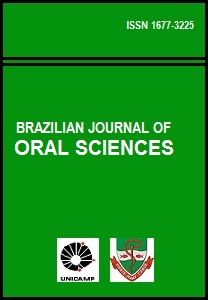Abstract
Amelogenins, a family of enamel extracellular matrix proteins, are abundantly expressed during tooth development. It is produced by the AMELX Xq22 and AMELY Yp11 genes and the level of transcription of AMELY locus appears to be only approximately 10% of amelogenin transcripts. DNA methylation is the major epigenetic mechanism of regulation of gene expression. Many factors can interfere in gene silencing, such as polymorphisms and nutrients and some genes escape inactivation, principally X-linked genes. The large number of genes that escape inactivation, and their non-random distribution on the chromosome X may have implications in abnormalities caused by genes on this chromossome. Defects of dental enamel formation are caused by genetic or environmental factors, including genetic polymorphisms and nutrient intake. However, the relationship between epigenetic and genetic factors in amelogenesis is not known. In this context, DNA methylation might be a promising path to explain not only the mechanisms of AMEL inactivation, but also in pathological situations.References
Simmer JP, Hu JC. Expression, structure, and function of enamel proteinases. Connect Tissue Res. 2002; 43: 441-9.
Salido EC, Yen PH, Koprivnikar K, Yu LC, Shapiro LJ. The human enamel protein gene amelogenin is expressed from both the X and the Y chromosomes. Am J Hum Genet. 1992; 50: 303-16.
Fincham AG, Moradian-Oldak J, Simmer JP. The structural biology of the developing dental enamel matrix. J Struct Biol. 1999; 126: 270-99.
Robinson C, Briggs HD, Kirkham J, Atkinson PJ. Changes in the protein components of rat incisor enamel during tooth development. Arch Oral Biol. 1983; 28: 993-1000.
Fincham AG, Moradian-Oldak J. Comparative mass spectrometric analyses of enamel matrix proteins from five species suggest a common pathway of post-secretory proteolytic processing. Connect Tissue Res. 1996; 35: 151-6.
Fincham AG, Lau EC, Simmer J, Zeichner-David M Amelogenin biochemistry-form and function. Amsterdam: Elsevier Science; 1992. p.187-201.
Robinson C, Brookes SJ, Shore RC, Kirkham J. The developing enamel matrix: nature and function. Eur J Oral Sci. 1998; 106(Suppl 1): 282-91.
Hart PS, Aldred MJ, Crawford PJ, Wright NJ, Hart TC, Wright JT. Amelogenesis imperfecta phenotype-genotype correlations with two amelogenin gene mutations. Arch Oral Biol. 2002; 47: 261-5.
Zvejnieks PA, Tellschow SR, Gudlaugsson EG, Markham N, Shroyer KR. Amelogenin dosage compensation in carcinoma of colon, lung, liver and kidney, is not a marker of clonality in males. Mol Cell Probes. 1998; 12: 185-90.
Rajpar MH, Harley K, Laing C, Davies RM, Dixon MJ. Mutation of the gene encoding the enamel-specific protein, enamelin, causes autosomal-dominant amelogenesis imperfecta. Hu Mol Genet. 2001; 10: 1673-7 11. Alvesalo L, Portin P. 47, XXX femals, sex chromosomes, and tooth crown structure. Hum Genet. 1987; 77: 345-8 12. Skaletsky H, Kuroda-Kawaguchi T, Minx PJ, Cordum HS, Hillier L, Brown LG, et. al.. The male-specific region of the human Y chromosome is a mosaic of discrete sequence classes. Nature. 2003; 423: 825-37.
Plath K, Mlynarczyk-Evans S, Nusinow DA, Panning B. Xist RNA and the mechanism of X chromosome inactivation. Annu Rev Genet. 2002; 36: 233-78.
Carrel L, Willard HF. X-inactivation profile reveals extensive variability in X-linked gene expression in females. Nature. 2005; 434: 400-4.
Ehrlich M. Expression of various genes is controlled by DNA methylation during mammalian development. J Cell Biochem. 2003; 88: 899-910.
Bird A. The essentials of DNA methylation. Cell. 1992 70:5-8.
Antequera F, Bird A. CpG islands as genomic footprints of promoters that are associated with replication origins. Curr Biol. 1999; 9: R661-7.
Cedar H. DNA methylation and gene activity. Cell. 1988; 53: 3-4.
Friso S, Choi SW. Gene-nutrient interactions and DNA methylation. J Nutr. 2002; 132(8 Suppl): 2382S-2387S.
Bird A, Taggart M, Frommer M, Miller OJ, Macleod D. A fraction of the mouse genome that is derived from islands of nonmethylated, CpG-rich DNA. Cell. 1985; 40: 91-9.
Leonhardt H, Cardoso MC. DNA methylation, nuclear structure, gene expression and cancer. J Cell Biochem Suppl. 2000; Suppl 35: 78-83.
Wenger RH, Kvietikova I, Rolfs A, Camenisch G, Gassmann M. Oxygen-regulated erythropoietin gene expression is dependent on a CpG ethylation-free hypoxia-inducible factor-1 DNAbinding site. Eur J Biochem. 1998; 253: 771-7.
Nan X, Ng HH, Johnson CA, Laherty CD, Turner BM, Eisenman RN et al. Transcriptional repression by the methyl-CpG-binding protein MeCP2 involves a histone deacetylase complex. Nature. 1998; 393: 386-9.
Georgel PT, Horowitz-Scherer RA, Adkins N, Woodcock CL, Wade PA, Hansen JC. Chromatin compaction by human MeCP2. Assembly of novel secondary chromatin structures in the absence of DNA methylation. J Biol Chem. 2003; 278: 32181-8.
Fuks F, Hurd PJ, Wolf D, Nan X, Bird AP, Kouzarides T. The methyl-CpG-binding protein MeCP2 links DNA methylation to histone methylation. J Biol Chem. 2003; 278: 4035-40.
Esteller M, Herman JG. Cancer as an epigenetic disease: DNA methylation and chromatin alterations in human tumours. J Pathol. 2002; 196: 1-7.
Wolffe AP, Matzke MA. Epigenetics: regulation through repression. Science. 1999; 286: 481-6.
Jones PA, Laird PW. Cancer epigenetics comes of age. Nat Genet. 1999; 21: 163-7.
Hsieh CL. Dependence of transcriptional repression on CpG methylation density. Mol Cell Biol. 1994; 14: 5487-94.
Jenuwein T, Allis CD. Translating the histone code. Science. 2001; 293: 1074-80.
Zegerman P, Canas B, Pappin D, Kouzarides T. Histone H3 lysine 4 methylation disrupts binding of nucleosome remodeling and deacetylase (NuRD) repressor complex. J Biol Chem. 2002; 277: 11621-4.
Lachner M, O’Carroll D, Rea S, Mechtler K, Jenuwein T. Methylation of histone H3 lysine 9 creates a binding site for HP1 proteins. Nature. 2001; 410: 116-20.
Chan GC, Fish JE, Mawji IA, Leung DD, Rachlis AC, Marsden PA. Epigenetic basis for the transcriptional hyporesponsiveness of the human inducible nitric oxide synthase gene in vascular endothelial cells. J Immunol. 2005; 175: 3846-61.
The Brazilian Journal of Oral Sciences uses the Creative Commons license (CC), thus preserving the integrity of the articles in an open access environment.

